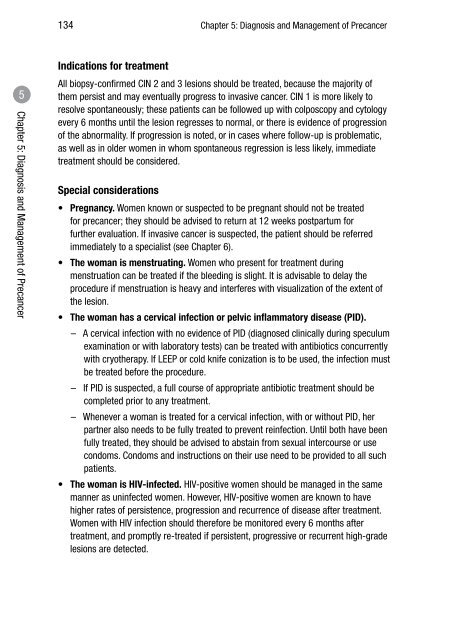CHAPTER 4: SCREENING FOR CERVICAL CANCER
CHAPTER 4: SCREENING FOR CERVICAL CANCER
CHAPTER 4: SCREENING FOR CERVICAL CANCER
You also want an ePaper? Increase the reach of your titles
YUMPU automatically turns print PDFs into web optimized ePapers that Google loves.
134 Chapter 5: Diagnosis and Management of Precancer5Chapter 5: Diagnosis and Management of PrecancerIndications for treatmentAll biopsy-confirmed CIN 2 and 3 lesions should be treated, because the majority ofthem persist and may eventually progress to invasive cancer. CIN 1 is more likely toresolve spontaneously; these patients can be followed up with colposcopy and cytologyevery 6 months until the lesion regresses to normal, or there is evidence of progressionof the abnormality. If progression is noted, or in cases where follow-up is problematic,as well as in older women in whom spontaneous regression is less likely, immediatetreatment should be considered.Special considerations• Pregnancy. Women known or suspected to be pregnant should not be treatedfor precancer; they should be advised to return at 12 weeks postpartum forfurther evaluation. If invasive cancer is suspected, the patient should be referredimmediately to a specialist (see Chapter 6).• The woman is menstruating. Women who present for treatment duringmenstruation can be treated if the bleeding is slight. It is advisable to delay theprocedure if menstruation is heavy and interferes with visualization of the extent ofthe lesion.• The woman has a cervical infection or pelvic inflammatory disease (PID).– A cervical infection with no evidence of PID (diagnosed clinically during speculumexamination or with laboratory tests) can be treated with antibiotics concurrentlywith cryotherapy. If LEEP or cold knife conization is to be used, the infection mustbe treated before the procedure.– If PID is suspected, a full course of appropriate antibiotic treatment should becompleted prior to any treatment.– Whenever a woman is treated for a cervical infection, with or without PID, herpartner also needs to be fully treated to prevent reinfection. Until both have beenfully treated, they should be advised to abstain from sexual intercourse or usecondoms. Condoms and instructions on their use need to be provided to all suchpatients.• The woman is HIV-infected. HIV-positive women should be managed in the samemanner as uninfected women. However, HIV-positive women are known to havehigher rates of persistence, progression and recurrence of disease after treatment.Women with HIV infection should therefore be monitored every 6 months aftertreatment, and promptly re-treated if persistent, progressive or recurrent high-gradelesions are detected.
















